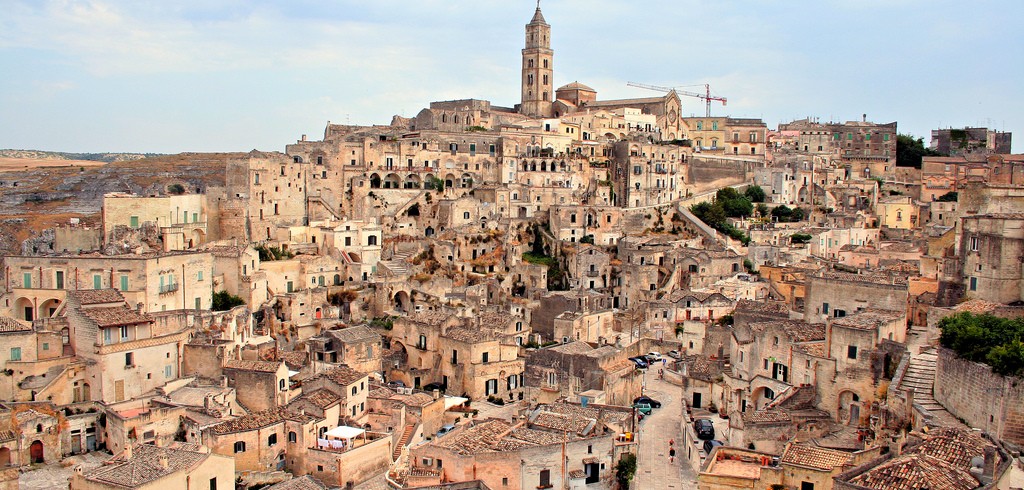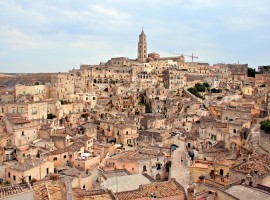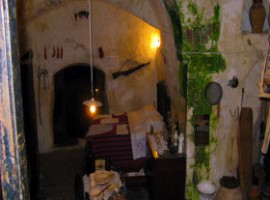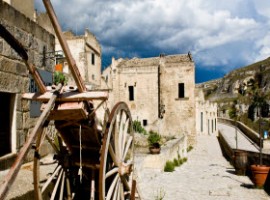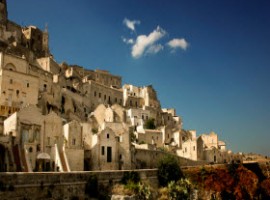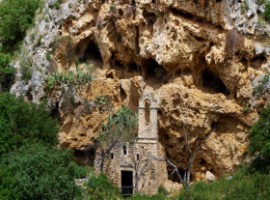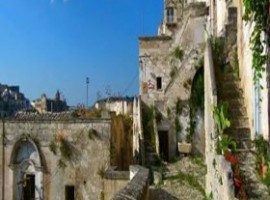A few days ago the EU awarded Matera the title of European Capital of Culture 2019.
This international reward is the final step in a long process which, over the last five years, has turned Matera from one of the poorest and lesser known Italian cities into one of the most popular tourist destinations.
In 1993 Matera had already been awarded the title of Unesco World Heritage Site.
But it was the cinema industry which first caught the incredible potential of Matera and its surrounding areas; many film directors, both Italian and international, chose Matera as the suggestive setting for their shoots.
The Italian intellectual Pier Paolo Pasolini, born in the far north east of Italy, picked this far away area of South Italy to shoot “The Gospel after Matthew” in 1964. Franco Rosi also chose the location to film “Christ stopped at Eboli” and, last but not least, Mel Gibson wanted his Christ to move through a Jerusalem in the Sassi of Matera in his “The Passion of Christ”.
So, aside from film shooting, what makes Matera and its surrounding area so enticing and worthy of its new found title?
I sassi
Since the dawn of time, the inhabitants of the small village known as Matera have lived in caves of tuff instead of building houses in wood, stone or straw.
These small or large caves have always been known as “Sassi”, which is Italian for stones.
Intense urbanization in the 50’s brought about an increase of the number of people living in the Sassi with a consequent decrease of the living conditions. Matera became the shame of Italy. Italian institutions forced people to evacuate the Sassi and moved out to condominiums and small, independent, purpose built houses.
The Sassi were then completely left abandoned.
Recently though, many Sassi have been turned into cool hotels, B&Bs and buildings aimed at bringing in tourists, which has brought the ghost town back to life.
It’s got a suggestive feel during the day, when the sun’s rays reflect on the striking white tuff walls. The view at night is moving: the little windows and doors shine with small, warm, trembling lights coming from hotel rooms and restaurants and you can’t but help feel like you’re in front of a real life Christmas scene.
It’s hard not to lose track of time and reality, walking up to the old city centre known as Civita, through winding lanes and steep stairs.
- Matera photography by Gianluca Canello via Flickr
- Sassi in Matera photography by Claudio via Flickr
- Sassi Matera photography by Maurizio Montanaro via Flickr
The Rupestrian churches of Matera
Matera and the surrounding territory of the Murgia has always attracted a great number of mystical groups who founded their communities and their churches there: Greek Byzantines, Benedict monks and Christian Catholic ones to name a few.
The number of these Rupestrian churches has been calculated at 155 so far, but the number is likely to increase as interest and economic investment keep growing.
Most of them are frescoed and some are, in places, not easy to reach.
Yet a visit to one or two of these churches reveals the strong mystic, mysterious atmosphere that’s brimming in this corner of Italy .
Santa Maria di Idris is one of the most famous ones. Located at the top of the Monterrone Rock in the area of Sasso Caveoso , the small church is made up of a single room, completely frescoed with a thin bell tower. An underground tunnel, again totally frescoed, connects the Santa Mariadi Idris Church to the Church of San Giovanni in Monterrone.
The Crypt of original sin
One of the Rupestrian churches of Matera, the “Sistina Chapel” of Matera has been discovered and brought back to its original beauty after having served for many centuries as a refuge for cattle.
In 1963 a group of enthusiastic citizens fought for the restoration of this long forgotten little jewel and thanks to their actions and to the works of the Zetema foundation, visitors can now admire these frescoes dating back to the IX century.
Locals know it as “The one hundred saint cave” due to the number of human figures portrayed on the cave walls. And when you realize that masters of art such as Giotto and Piero della Francesca were not even born yet, the pictorial ability of these Rupestrian painters is really quite breathtaking.
Info: Reservations to visit required
Visits available from Tue to Sun
info@artezeta.it
- Matera photography by Diego Forneo via Flickr
- Rupestrian Church in the area around Matera photography by Emilius da atlantide via Flickr
- Matera photography by Borghy52 via Flickr
Casa Noha
If you have been charmed by the view of the Sassi and wish to know more, you can’t miss a visit to Casa Noha. The FAI, the private Italian foundation working to save and protect the beauty of Italy, has turned this dwelling in the old city center of Matera into a museum, where visitors are shown via video the life of Matera and its Sassi since the first Paleolithical settling.
Info: Recinto Cavone, 9 Matera
T. 0835 335452 – Fax 0835 330987
fainoha@fondoambiente.it
Matera specialities
Though based on very basic, staple ingredients, the cuisine of Matera is incredibly fresh and combines a high level of creativity to produce mouthwatering food.
Cialledd: dry bread, potatoes, onions, herbs of the local fields and an egg when times were good. It was customary to mix flowers- the asphodelus- on the plate and yellow asphodeluses were preferred over white ones as they were thought to contain more protein.
Cruschi Peppers: prepared to remain crunchy and sweet for longer, the cruschi peppers are one of the typical specialties of Matera and can be tasted in a variety of dishes.,
The pasta made from “grano arso”: long ago, it was customary to burn the remains of the corn that countrymen left on the ground. Though incinerated, the corn was ground and the wheat used for a pasta with a somewhat unique, smoked taste.
This tradition has now been revived and a portion of corn is roasted in order to obtain this wheat that some connoisseurs have learned to love.
Want to stay in the Sassi? Check availability at B&B Conte Gattini or at B&B Villa Paola
Cover image: Matera, ph. by Gianluca Canello, via flickr
